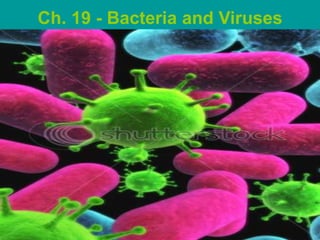Report
Share

Recommended
More Related Content
What's hot
What's hot (20)
Introduction to biology by dr. martin otundo richard

Introduction to biology by dr. martin otundo richard
Viewers also liked
Viewers also liked (20)
Phylogenomic Revisit for Green Contribution to Diatoms

Phylogenomic Revisit for Green Contribution to Diatoms
Similar to Bacteria
Similar to Bacteria (20)
Ultrastructure and characterstic features of bacteria.

Ultrastructure and characterstic features of bacteria.
Morphology & physiology of bacteria dr. someshwaran Microbiology

Morphology & physiology of bacteria dr. someshwaran Microbiology
More from legoscience
More from legoscience (20)
Recently uploaded
https://app.box.com/s/7hlvjxjalkrik7fb082xx3jk7xd7liz3TỔNG ÔN TẬP THI VÀO LỚP 10 MÔN TIẾNG ANH NĂM HỌC 2023 - 2024 CÓ ĐÁP ÁN (NGỮ Â...

TỔNG ÔN TẬP THI VÀO LỚP 10 MÔN TIẾNG ANH NĂM HỌC 2023 - 2024 CÓ ĐÁP ÁN (NGỮ Â...Nguyen Thanh Tu Collection
Recently uploaded (20)
Interdisciplinary_Insights_Data_Collection_Methods.pptx

Interdisciplinary_Insights_Data_Collection_Methods.pptx
NO1 Top Black Magic Specialist In Lahore Black magic In Pakistan Kala Ilam Ex...

NO1 Top Black Magic Specialist In Lahore Black magic In Pakistan Kala Ilam Ex...
UGC NET Paper 1 Mathematical Reasoning & Aptitude.pdf

UGC NET Paper 1 Mathematical Reasoning & Aptitude.pdf
Basic Civil Engineering first year Notes- Chapter 4 Building.pptx

Basic Civil Engineering first year Notes- Chapter 4 Building.pptx
HMCS Max Bernays Pre-Deployment Brief (May 2024).pptx

HMCS Max Bernays Pre-Deployment Brief (May 2024).pptx
On National Teacher Day, meet the 2024-25 Kenan Fellows

On National Teacher Day, meet the 2024-25 Kenan Fellows
Salient Features of India constitution especially power and functions

Salient Features of India constitution especially power and functions
Unit 3 Emotional Intelligence and Spiritual Intelligence.pdf

Unit 3 Emotional Intelligence and Spiritual Intelligence.pdf
Micro-Scholarship, What it is, How can it help me.pdf

Micro-Scholarship, What it is, How can it help me.pdf
Food safety_Challenges food safety laboratories_.pdf

Food safety_Challenges food safety laboratories_.pdf
TỔNG ÔN TẬP THI VÀO LỚP 10 MÔN TIẾNG ANH NĂM HỌC 2023 - 2024 CÓ ĐÁP ÁN (NGỮ Â...

TỔNG ÔN TẬP THI VÀO LỚP 10 MÔN TIẾNG ANH NĂM HỌC 2023 - 2024 CÓ ĐÁP ÁN (NGỮ Â...
ICT role in 21st century education and it's challenges.

ICT role in 21st century education and it's challenges.
Bacteria
- 1. Ch. 19 - Bacteria and Viruses Chapter 19
- 2. 19-1 Bacteria • Common name for all prokaryotes • unicellular organisms without a nucleus • Were all in Monera • Eubacteria • live nearly everywhere • normally protected by cell wall containing peptidoglycan - cell membrane inside of cell wall
- 3. • Archaebacteria • lack peptidoglycan • DNA similar to eukaryotic DNA • most are extremophiles – live in harsh environments • methanogens; halophiles; extreme thermophiles
- 4. Prokaryotic Body Plan pilus DNA bacterial flagellum capsule plasma membrane cell wall ribosomes in cytoplasm cytoplasm
- 5. Identifying Prokaryotes 1. Shape a. bacilli(us) – rod-shaped b. cocci(us) – spherical c. spirilla(us) – spiral and corkscrew shaped 2. Cell Walls a. Gram-positive – have thick peptidoglycan cell walls that take and hold stain b. Gram-negative – thinner cell walls with lipids on outside – does not hold stain Gram Positive Gram Negative 3. Movement
- 7. Metabolic Diversity 1. Chemoheterotrophs – must take in organic molecules for energy and a supply of carbon 2. Photoheterotrophs – use photosynthesis for energy, but take in organic compounds for carbon source 3. Photoautotrophs – use photosynthesis for both energy and carbon source 4. Chemoautotrophs – use chemosynthesis – get energy from chemical reactions and use carbon dioxide as carbon source
- 8. Releasing Energy - bacteria release energy by cellular respiration and fermentation A.Obligate Aerobes - require a constant supply of oxygen B. Obligate Anaerobes - must live in the absence of oxygen C. Facultative Anaerobes - can survive with or without oxygen
- 9. Growth and Reproduction - under good conditions bacteria can reproduce every 20 minutes Binary Fission - normal asexual reproduction of bacteria - replicate DNA and then divide Conjugation - exchange of genetic material between bacterial cells - increases genetic diversity Spore Formation - allows survival of bad conditions for a long time
- 10. Prokaryotic Fission - 1 bacterial chromosome Bacterium before DNA replication DNA replication begins Figure 21.7 Page 350
- 11. Prokaryotic Fission - 2 parent DNA molecule DNA replication completed DNA copy Membrane growth moves DNA molecules apart
- 12. Prokaryotic Fission - 3 New membrane and cellwall material deposited Cytoplasm divided in two
- 13. nicked plasmid in donor cell Conjugation Transfer of plasmid conjugation tube to recipient cell
- 14. Importance of Bacteria - while we usually think of bacteria negatively they are actually essential to correct functioning in ecosystems A. Decomposers - primary decomposers who make nutrients available to plants - used in sewage treatment plants also B. Nitrogen Fixers - Rhizobium in nodules of legume roots fix nitrogen in a form the plants can use
- 15. C. Human Uses • in food production • in industry – can clean-up oil spills • to synthesize drugs and chemicals • genetic engineering now has them producing human hormones • Mutualism with Eschecaria coli in our colon where they help us make vitamins